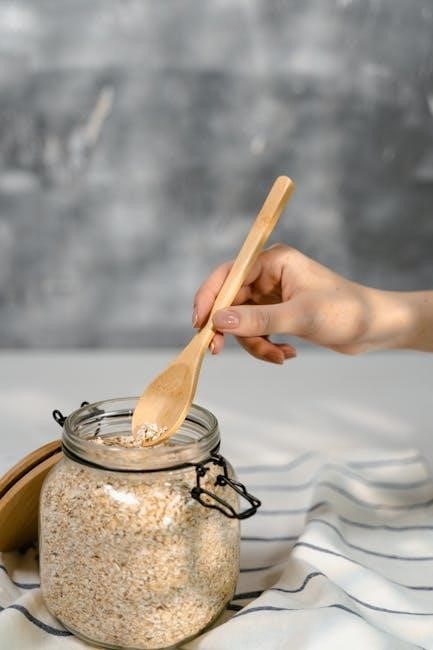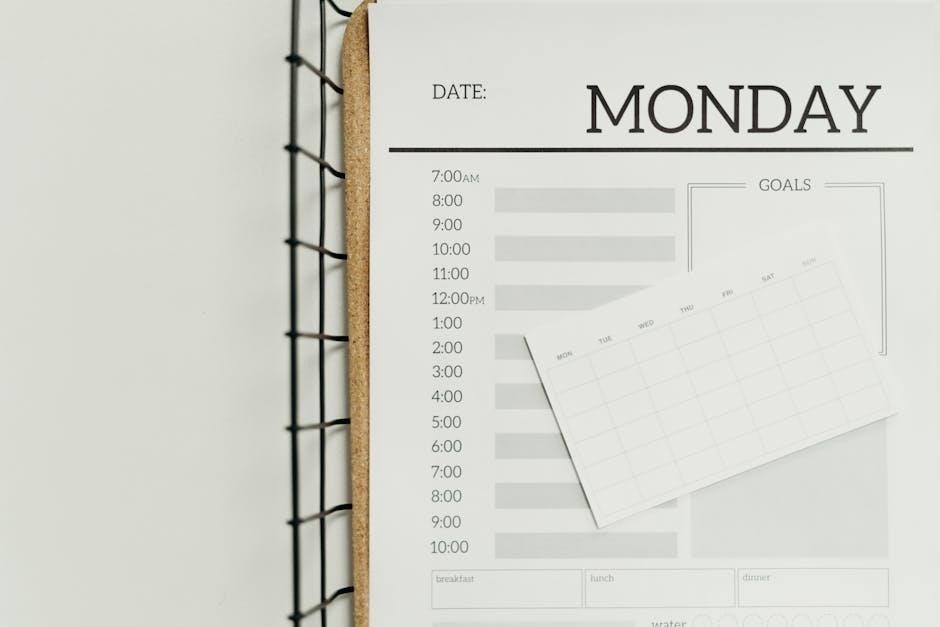Gastroesophageal reflux disease (GERD) is a chronic condition where stomach acid flows back into the esophagus, causing discomfort․ Diet plays a crucial role in managing symptoms, as certain foods can trigger or alleviate acid reflux․ A structured meal plan, such as a 7-day GERD diet plan, helps identify trigger foods and promotes balanced eating to reduce discomfort and improve digestion․ This approach focuses on low-acid, easily digestible foods to alleviate symptoms effectively․
Understanding GERD and Its Symptoms
Gastroesophageal reflux disease (GERD) is a chronic condition where stomach acid frequently flows back into the esophagus, causing discomfort and inflammation․ Common symptoms include heartburn, a burning sensation in the chest, regurgitation of food, difficulty swallowing, and coughing․ These symptoms occur when the lower esophageal sphincter (LES) weakens or malfunctions, allowing acid to move upward․ Over time, untreated GERD can lead to complications like esophagitis or narrowing of the esophagus․ While symptoms can vary in severity, they often worsen after eating, lying down, or consuming trigger foods․ Understanding these symptoms is crucial for early diagnosis and effective management, particularly through dietary adjustments and lifestyle changes․
The Role of Diet in Managing GERD Symptoms

Diet plays a pivotal role in managing GERD symptoms by identifying and avoiding trigger foods that exacerbate acid reflux․ Foods high in acid, fat, or spice can relax the lower esophageal sphincter (LES), allowing stomach acid to flow back into the esophagus․ By adopting a GERD-friendly diet, individuals can significantly reduce the frequency and severity of symptoms․ A structured meal plan, such as a 7-day GERD diet plan, helps eliminate problematic foods while promoting balanced nutrition․ This approach focuses on low-acid, high-fiber, and easily digestible foods that soothe the esophagus and improve digestion․ Additionally, portion control and meal timing are essential to prevent overloading the stomach, which can worsen reflux․ A well-designed diet not only alleviates symptoms but also supports long-term digestive health and overall well-being․

Key Foods to Avoid in a GERD Diet Plan
Common GERD triggers include acidic foods (citrus, tomatoes), fatty or fried foods, spicy dishes, carbonated beverages, chocolate, and caffeine․ These can relax the lower esophageal sphincter, worsening symptoms․
Acidic Foods and Their Impact on GERD
Acidic foods, such as citrus fruits, tomatoes, vinegar, and processed foods, can exacerbate GERD symptoms by increasing stomach acid production․ These foods lower the pH level in the stomach, which can irritate the esophagus and trigger heartburn․ Consuming high-acid foods regularly can weaken the lower esophageal sphincter (LES), making it less effective at preventing acid reflux․ Incorporating non-acidic alternatives, such as low-acid fruits like bananas or melons, can help reduce discomfort․ Avoiding acidic beverages, like soda or fruit juices, is also crucial․ By eliminating these triggers, individuals can significantly alleviate GERD symptoms and promote a healthier digestive system․ A 7-day GERD diet plan often highlights these adjustments to help manage acid reflux effectively․
Fatty and Spicy Foods: Triggers for Acid Reflux
Fatty and spicy foods are well-known triggers for acid reflux in individuals with GERD․ Fatty foods, such as fried items, red meat, and full-fat dairy, slow digestion, allowing stomach acid to linger and potentially reflux into the esophagus․ Spicy foods, particularly those containing capsaicin, can irritate the esophagus and relax the lower esophageal sphincter (LES), exacerbating symptoms․ Examples of problematic foods include chili peppers, heavy sauces, and processed meats․ Incorporating lean proteins, low-fat dairy, and mildly flavored dishes can help reduce discomfort․ A 7-day GERD diet plan often emphasizes avoiding these triggers while suggesting healthier alternatives to manage symptoms effectively and improve digestion․ Balancing meals with non-irritating ingredients is key to alleviating acid reflux and promoting long-term relief․
Carbonated Beverages and Sugary Drinks
Carbonated beverages and sugary drinks are common triggers for acid reflux in GERD patients․ These drinks can relax the lower esophageal sphincter (LES), allowing stomach acid to flow back into the esophagus․ Carbonated drinks, such as sodas and sparkling water, produce gas, which can increase pressure on the stomach and worsen reflux symptoms․ Sugary drinks, like fruit juices and sweetened teas, can contribute to inflammation and discomfort․ Additionally, these beverages often have high acid content, further irritating the esophagus․ To manage GERD effectively, it’s recommended to avoid these drinks and opt for water, herbal teas, or low-acid juices instead․ Staying hydrated with water is especially important, as it helps dilute stomach acid and supports digestion․ Incorporating these changes into a 7-day GERD diet plan can significantly reduce symptoms and improve overall comfort․

Best Foods to Include in a GERD-Friendly Diet
Incorporating low-acid fruits, vegetables, lean meats, and healthy fats into your diet can help alleviate GERD symptoms․ These foods promote easier digestion and reduce inflammation, supporting long-term relief․
Low-Acid Fruits and Vegetables
Incorporating low-acid fruits and vegetables into your GERD-friendly diet is essential for managing symptoms․ Opt for options like bananas, melons, cucumbers, spinach, and green beans, which are gentle on the esophagus․ These foods are less likely to trigger acid reflux and can help soothe irritation․ Avoid citrus fruits, tomatoes, and raw onions, as they are high in acid․ Cooking vegetables lightly or steaming them can further reduce acidity․ Pairing these fruits and vegetables with lean proteins or healthy fats enhances digestion and provides balanced nutrition․ By focusing on these low-acid choices, you can create meals that are both nourishing and symptom-friendly․ This approach supports long-term relief and overall digestive health․
Lean Meats and Their Benefits for GERD
Lean meats are an excellent choice for a GERD-friendly diet, as they are less likely to trigger acid reflux compared to fatty or processed options․ Opt for poultry like chicken or turkey, and select lean cuts of beef or pork․ Fish, such as cod or tilapia, is also a great option due to its low fat content and anti-inflammatory properties․ Avoid frying or adding heavy sauces, as these can increase acidity and worsen symptoms․ Instead, grill, bake, or steam meats to keep them tender and low in fat․ Incorporating lean meats into your meals provides essential protein while minimizing digestive discomfort, making them a valuable part of your GERD management plan․
Healthy Fats and Their Role in Digestion

Healthy fats are a vital component of a GERD-friendly diet, supporting digestion without triggering acid reflux․ Avocados, olive oil, and nuts are excellent sources of healthy fats that can help slow digestion, reducing the likelihood of stomach acid flowing back into the esophagus․ These fats are also less likely to irritate the esophagus compared to fried or high-fat foods․ Incorporating small portions of these fats into meals can enhance satiety and provide essential nutrients․ However, moderation is key, as overconsumption of any fat can still provoke symptoms․ Pairing healthy fats with lean proteins and low-acid vegetables creates balanced meals that support overall digestive health and alleviate GERD discomfort effectively․

7-Day GERD Diet Plan Overview
A structured 7-day GERD diet plan provides a comprehensive approach to managing symptoms through balanced meals․ It focuses on low-acid foods, portion control, and nutrient-rich recipes to alleviate discomfort and improve digestion effectively․
Day 1 of the 7-day GERD diet plan introduces gentle, low-acid meals to ease symptoms․ Start with oatmeal for breakfast, paired with non-citrus fruits like bananas or berries․ For lunch, opt for grilled chicken or fish with steamed vegetables like green beans or carrots․ Dinner could include quinoa or brown rice with lean turkey or tofu․ Snacks like almonds or cucumber slices are ideal․ Avoid spicy, fatty, or carbonated foods․ This day focuses on resetting your palate and identifying foods that soothe digestion․ The meals are designed to be simple, flavorful, and easy to prepare, setting the foundation for a week of symptom relief and dietary balance․
Day 2: Balancing Nutrients and Flavors
Day 2 emphasizes balancing nutrients and flavors while keeping meals GERD-friendly․ Breakfast could include scrambled eggs with spinach and mushrooms, paired with whole-grain toast․ For lunch, opt for a grilled chicken salad with mixed greens, cucumber, and a light vinaigrette․ Dinner might feature baked cod with roasted vegetables like zucchini and carrots․ Snacks include rice cakes with almond butter or sliced bell peppers․ The focus is on incorporating lean proteins, fiber-rich vegetables, and healthy fats to stabilize digestion․ Flavors are enhanced with herbs like basil or parsley instead of spices․ Portion control and mindful eating are encouraged to avoid overfilling the stomach, reducing acid reflux triggers․ This day highlights how nutritious meals can be delicious and symptom-free․
Day 3: Incorporating Snacks and Desserts
Day 3 focuses on adding snacks and desserts that are GERD-friendly while maintaining balanced nutrition․ Snacks like fresh berries, sliced bananas, or cucumber sticks with hummus are ideal․ For desserts, consider low-acid options such as almond cookies or fruit-based parfaits made with non-dairy yogurt․ These choices avoid trigger foods like chocolate or citrus, which can worsen reflux․ Incorporating small, frequent meals helps manage symptoms and prevents overeating at main meals․ Staying hydrated with water or herbal teas is also encouraged․ This day highlights how snacks and desserts can be enjoyable while adhering to a GERD diet, ensuring comfort and symptom relief without sacrificing flavor or variety․
Day 4: Meal Prep Tips for Convenience
Day 4 emphasizes the importance of meal prep to simplify your GERD-friendly diet․ By planning and preparing meals in advance, you can avoid last-minute decisions that may lead to consuming trigger foods․ Start by portioning out breakfast options like overnight oats or smoothies made with non-acidic fruits․ Chop vegetables and lean proteins for salads or stir-fries, ensuring they are ready for quick assembly․ Prepare snacks such as veggie sticks with low-fat dips or small servings of fresh, non-citrus fruits․ Label and store meals in airtight containers for easy reheating․ Staying organized not only saves time but also helps maintain consistency in your diet, reducing the likelihood of symptom flare-ups․ Meal prep is a key strategy for long-term success in managing GERD through dietary changes․

Day 5: Dining Out Strategies
Dining out while managing GERD requires careful planning to avoid trigger foods․ Opt for non-acidic, low-fat options such as grilled lean meats, steamed vegetables, and whole grains․ Avoid spicy dishes, fried items, and high-fat sauces, which can exacerbate symptoms․ Choose water or herbal teas instead of carbonated or sugary drinks․ Inform your server about dietary restrictions and ask for modifications, such as no added cheese or cream․ Select smaller portions to prevent overeating, which can worsen reflux․ Avoid lying down after meals and allow at least 2-3 hours before bedtime for proper digestion․ By making mindful choices and communicating with restaurant staff, you can enjoy dining out while staying on track with your GERD-friendly diet․
Day 6: Avoiding Trigger Foods

Identifying and eliminating trigger foods is essential for managing GERD symptoms․ Common culprits include acidic foods like citrus fruits and tomatoes, fatty or fried foods, spicy dishes, chocolate, caffeine, and carbonated beverages․ These foods can relax the lower esophageal sphincter or irritate the esophagus, leading to acid reflux․ On Day 6, focus on avoiding these triggers and opt for low-acid, non-spicy, and low-fat alternatives․ For example, choose alkaline fruits like bananas or melons instead of oranges or grapefruits․ Avoid processed snacks and opt for lean proteins like poultry or fish․ Reading food labels can help identify hidden triggers, such as high-fat content or added acids․ By making conscious food choices, you can significantly reduce GERD symptoms and create a foundation for long-term relief․
Day 7: Sustaining Long-Term Symptom Relief
By Day 7, you’ve established a foundation for managing GERD symptoms through dietary changes․ The key to long-term relief is consistency and mindful eating․ Avoid reverting to old habits, as this can trigger acid reflux․ Continue focusing on low-acid, lean, and balanced meals while staying hydrated to support digestion․ Incorporate physical activity, as it aids digestion and overall health․ Tracking your progress in a food diary helps identify patterns and potential triggers․ Gradually reintroduce foods one at a time to assess tolerance․ Remember, small, frequent meals are better than large portions․ Seek support from healthcare professionals or dietitians for personalized advice․ With commitment, you can maintain symptom relief and enjoy a healthier, more comfortable lifestyle․ The 7-day GERD diet plan PDF serves as a valuable guide for ongoing reference and adjustment․

Additional Tips for Managing GERD
Elevate your head during sleep, chew food thoroughly, and manage stress to reduce symptoms․ Avoid tight clothing and monitor progress to tailor your diet effectively․
Meal Timing and Portion Control
Meal timing and portion control are essential for managing GERD symptoms․ Eating smaller, balanced meals throughout the day can help prevent overeating, which often triggers acid reflux․ Avoid heavy meals close to bedtime, as lying down after eating can worsen symptoms․ Allow at least 2-3 hours between your last meal and bedtime to give your stomach time to digest․ Additionally, avoid grazing or skipping meals, as this can disrupt digestion․ Hydration is key, but drink water between meals rather than during to prevent overwhelming the stomach․ Monitoring portion sizes helps reduce pressure on the lower esophageal sphincter, minimizing acid reflux episodes․ A structured approach to meal timing and portion control can significantly improve GERD management and overall comfort․
Hydration: The Role of Water in Digestion
Hydration plays a vital role in digestion and managing GERD symptoms․ Drinking water helps dilute stomach acid, reducing its potency and minimizing irritation to the esophagus․ Proper hydration also supports the digestive system by preventing constipation and ensuring nutrients are absorbed effectively․ However, timing is crucial; avoid drinking large amounts of water during or immediately after meals, as this can overwhelm the stomach and worsen reflux․ Instead, sip water between meals to maintain consistent hydration without disrupting digestion․ Additionally, avoid sugary or carbonated beverages, as they can irritate the esophagus and trigger symptoms․ Staying hydrated with water is a simple yet effective way to support digestive health and alleviate GERD discomfort;
Keeping a Food Diary for Symptom Tracking
Keeping a food diary is a powerful tool for managing GERD symptoms․ By tracking your daily meals, snacks, and beverages, you can identify which foods trigger acid reflux or discomfort․ Note the time of consumption, portion sizes, and any symptoms experienced afterward․ This helps pinpoint specific triggers and monitor how your body reacts to different foods․ Over time, the diary provides valuable insights to refine your diet and reduce symptom frequency․ Additionally, it can help track progress and identify patterns, making it easier to adjust your meal plan․ A food diary is a personalized approach to understanding your digestive health and ensuring long-term success with your GERD management plan․

Downloading the 7-Day GERD Diet Plan PDF
Access a free, printable 7-Day GERD Diet Plan PDF to simplify meal planning and symptom management․ This resource provides structured guidance for low-acid meals and snacks․
Benefits of a Printable Meal Plan
A printable 7-Day GERD Diet Plan PDF offers numerous benefits, including convenience, clarity, and consistency in managing symptoms․ It provides a structured guide for meals and snacks, ensuring you stay on track with GERD-friendly foods․ The ability to print the plan allows for easy reference during grocery shopping or meal preparation․ It also serves as a motivational tool, helping you commit to dietary changes․ By having a clear plan, you can avoid decision fatigue and reduce stress, focusing instead on healing and symptom relief․ The printable format makes it easy to share with family or caregivers, ensuring everyone is aligned with your dietary goals․ Overall, a printable meal plan is a practical and effective way to take control of your GERD management․
How to Access the Free PDF Resource
Accessing the free 7-Day GERD Diet Plan PDF is straightforward and convenient․ Simply visit the designated website or platform offering the resource and locate the download link․ Most sites provide a direct link or a simple sign-up form to access the PDF․ Once downloaded, you can print the meal plan for easy reference during shopping or meal preparation․ Some resources may require creating a free account, but the process is typically quick and user-friendly․ Ensure you download the PDF from a reputable source to guarantee accuracy and safety․ With the plan in hand, you can effortlessly follow the structured meals and snacks designed to alleviate GERD symptoms and improve your digestive health․
